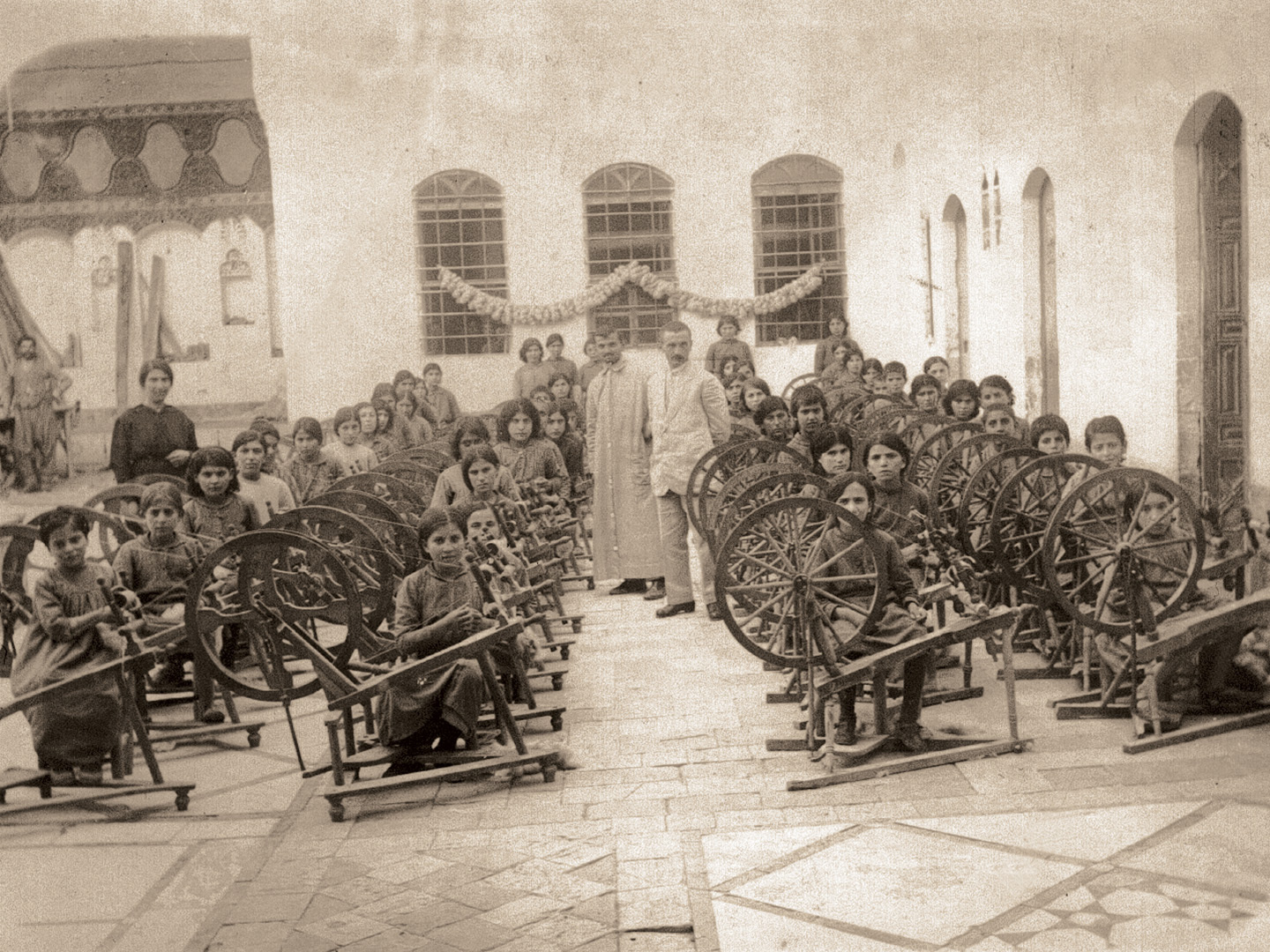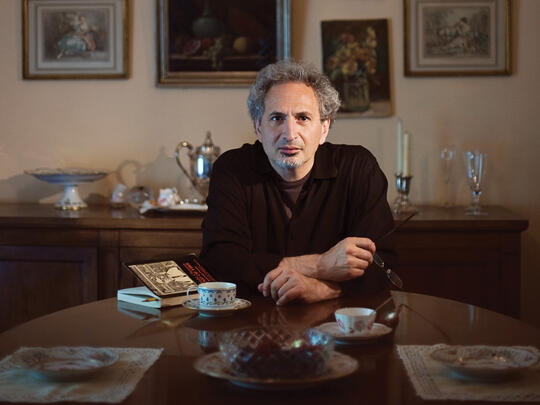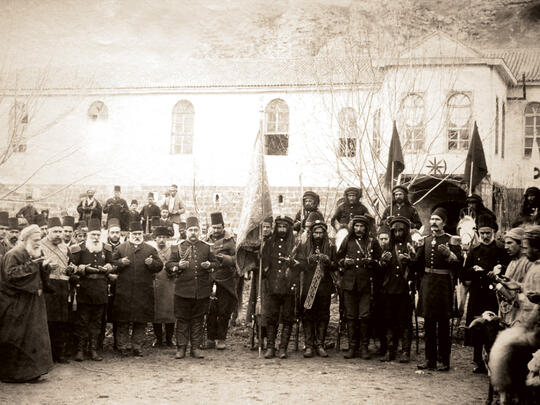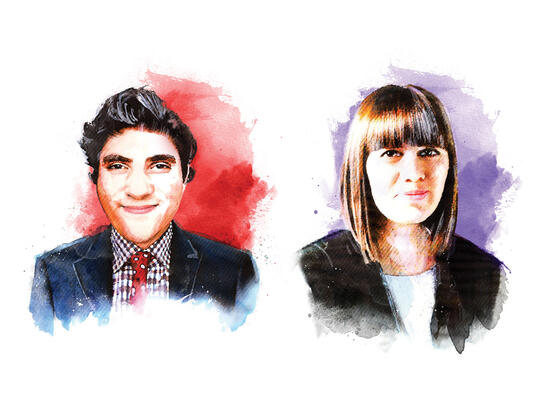The first phase of the Armenian General Benevolent Union’s (AGBU) humanitarian relief efforts took place during the Adana massacres in 1909, most notably through assistance provided to Cilician Armenian refugees in Dörtyol in the province of Alexandretta. These initiatives, as well as the schools and local committees the organization founded in the years immediately before the war, marked the beginning of AGBU’s involvement in the Ottoman Empire.
In the fall of 1915, AGBU took over the management of an Armenian refugee camp for natives of Musa Dagh founded by the British in Port Said, Egypt and opened the Sissouan School for the thousands of children in the camp. From 1917 to 1918, the organization came to the aid of Armenian refugees discovered by the British military in Palestine and Jordan and founded the Araradian Orphanage in Jerusalem in the Monastery of Saint James. The Araradian Orphanage was the first in what would become a network of orphanages established in all the major cities of the Near East, Egypt and Greece, as well as in Cilicia.

During the same period, AGBU launched a campaign to recover the thousands of Armenian deportees scattered in the mountains of Jabal al-Druze and in the region surrounding Damascus. Among them were many women and children who had been abducted or sold and had been living in Bedouin tribes in Palestine and Jordan. The organization financed the operation of a small group of 60 men—former soldiers and deserters of the Ottoman Army—formed by Hovhannes Keledjian and led by Levon Yotneghperian. As a result of the cooperation of Emir Faisal, son of the Grand Sharif of Mecca and leader of the Arab revolt against the Ottomans during the British offensive, Yotneghperian’s group managed to collect 2,000 deportees from Jabal al-Druze in the summer and fall of 1918 and send them to British-controlled zones, in particular to Dera’a and then to Damascus.
The group continued its efforts throughout 1919, focusing on liberating Armenian slaves held captive by Bedouin tribes. During the same period, a similar group led by Roupen Herian was rescuing hundreds of women and children in the regions of Aleppo and Der Zor. After the signing of the Armistice of Moudros on October 31, 1918 and the subsequent Allied occupation of Syria and Cilicia, AGBU estimated that 40,000 deportees were living in regions around Aleppo and between 20,000 and 30,000 around Damascus. The number of survivors was much lower than that which the organization’s leaders in Cairo had hoped, since the deportees who had not been massacred had often died as a result of famine, disease and exposure to the elements.

Support for the tens of thousands of refugees—with, for example, the creation of shelters in Aleppo and Damascus for women and children who had been held captive—and the organization of a repatriation campaign to return deportees to their native regions represented a major challenge for AGBU and the various Armenian humanitarian organizations created at the end of the war. Tens of thousands of Christian refugees—Syriac, Chaldean, Assyrian and Armenian—also remained in Iraq after the war: approximately 10,000 Armenians in Mosul, 15,000 in the camp of Bakouba near Baghdad and, after its closing by the British, 14,000 refugees in the camp of Nahr el-Omar near Basra in 1921 where AGBU and the Near East Relief were put in charge of the orphans as they awaited transfer out of Iraq. AGBU also managed orphanages and refugee camps in Aintoura in Lebanon and Haifa and Jerusalem in Palestine.
At the beginning of 1919, the Allied Powers decided to move the Armenian deportees from camps in Syria and Palestine to their towns and villages of origin in Asia Minor. The French forces established a central service for Armenian repatriation in Aleppo, which was tasked with sending the tens of thousands of Armenians still living in the refugee camps of Aleppo and Beirut back to their homes in Cilicia. Concerned with hastening the return of the refugees in order to prevent any hostility their arrival might evoke and to spare Emir Faisal’s newly established regime in Syria, the British recklessly accelerated the repatriation campaign. Emptying the region of Aleppo, they sent the Armenian refugees to Cilicia and then to the regions of Marash, Ourfa and Aintab, without preparing for the material conditions the refugees would face upon their return. For the Allies, it was a matter of urgency to send all Armenian refugees out of Syria and Palestine for political as well as financial reasons, despite the reticence of the French military administration in Cilicia that was faced with a rapid influx of refugees it was not prepared to receive. 100,000 refugees are estimated to have been repatriated to Cilicia and the neighboring regions in 1919. With the help of other Armenian and Western humanitarian organizations, such as the Near East Relief, AGBU worked to reintegrate these populations, along with the French administration, by founding schools and orphanages, most notably in Mersine, Dörtyol and Hadjın, where AGBU had transferred its dispensary and hospital from Damascus. AGBU also restarted a number of local AGBU committees in Antioch, Zeitoun, Adana, Sis, Hadjın, Aintab, Marash, Ourfa and Biredjik, among others. In Dörtyol, two orphanages—the Kelekian and Sissouan Orphanages—collected Armenian orphans in the regions around Homs and Hama in Syria as well as children whose parents had been victims of the violence that the Kemalist troops had inflicted in the regions bordering Cilicia.

With the enthusiasm generated by the movement of mass return to Cilicia, the AGBU Central Board in Cairo chose in 1919 to evacuate the refugee camp and Sissouan Orphanage in Port Said and move the refugees to Mersine. The majority of the Armenians who had returned to Cilicia were in need of material aid. The local AGBU chapters distributed clothing made in the organization’s workshops in Cairo and Aleppo, granted loans to families and participated in aid programs for farmers in Zeitoun and Marash.
However, the Kemalist offensive in Marash, Ourfa, Aintab and the main cities of Cilicia in 1920 occasionally subjected the Armenians to new rounds of massacres. In Hadjın, for instance, thousands of Armenians, including children at the AGBU orphanage were killed, putting a brutal end to the idea of fashioning Cilicia into a national center for the Armenians. The gradual evacuation of French forces and the signing of the Ankara Agreement in 1921, through which France ceded Cilicia to Turkey, pushed the barely resettled Armenians back into exile once again. In the spring of 1920, Zabel Yessayan, the head of an inspection mission of the orphanages in Cilicia, envisioned transferring the Armenian orphans in Cilicia to Beirut and Cyprus. By November and December of 1921, most of the Armenians and other Christians of Cilicia had left the region for Syria and Lebanon.
After 1921, AGBU relief efforts would focus primarily on the two main Near Eastern centers, as well as Cyprus and Jerusalem, abandoning the dream of resettling Armenians in their towns and villages of origin in Turkey. Several years later, AGBU would begin to direct its efforts towards Soviet Armenia, seeing its potential as a site for national resurgence.
Banner photo is courtesy of Mekhitarists of Venice Collection
















